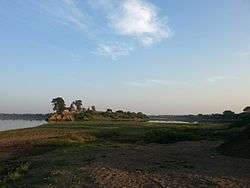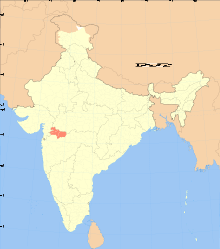Khandesh
Khandesh is a geographic region in Central India, which forms the northwestern portion of Maharashtra state.[1]
Khandesh | |
|---|---|
 Landscape of the Tapi River in Dhule district. | |
 Blue: Khandesh in Maharashtra Light Blue: Khandesh in Madhya Pradesh (Burhanpur) | |
| Country | India |
| State | Maharashtra and Madhya Pradesh |
| Languages | Khandeshi |
| Elevation | 240 m (790 ft) |
| Demonym(s) | Khandeshi |

Geography
Khandesh lies in Central India on the northwestern corner of the Deccan Plateau, in the valley of the Tapi River. It is bounded to the north by the Satpura Range, to the east by the Berar (Varhad) region, to the south by the Hills of Ajanta (belonging to the Marathwada region of Maharashtra), and to the west by the northernmost ranges of the Western Ghats.
The principal natural feature is the Tapi River.[2] Unlike the rest of the Deccan, whose rivers rise in the Western Ghats and flow eastward to the Bay of Bengal, the Tapi flows westward from headwaters in southern Madhya Pradesh to empty into the Arabian Sea. The Tapi receives thirteen principal tributaries in its course through Khandesh. None of these rivers is navigable, and the Tapi flows in a deep bed which historically made it difficult to use for irrigation. Most of Khandesh lies south of the Tapi and is drained by its tributaries: the Girna, Bori and Panjhra. The alluvial plain north of the Tapi contains some of the richest tracts in Khandesh, and the land rises towards the Satpuda hills. In the centre and east, the country is level, save for some low ranges of barren hills. To the north and west, the plain rises into rugged hills, thickly wooded, and inhabited by the tribal Bhil people.[3]
History
Delhi dynasties
In 1295, Khandesh was under the Chauhan ruler of Asirgarh when Ala-ud-din Khilji of Delhi wrested control.[4]:418 Various Delhi dynasties controlled Khandesh over the next century.[4]:418 From 1370 to 1600, the Faruqi dynasty ruled Khandesh with the capital at Burhanpur.[4]:418 The foundation of Khandesh as an independent kingdom was laid by Malik Raja, son of Khanjahan Faurki. Firuz Shah Tughlaq (1309 – 20 September 1388) had initially appointed Malik Raja as the commander-in-chief of Khandesh region, but he declared himself independent after the death of Firoz Tughlaq and ruled until 1399.[5]
Mughal rule
The Mughals arrived in 1599, when Akbar's army overran Khandesh and captured Asirgarh.[4]:418 For a period of time, Khandesh was renamed as Dandesh in recognition of Akbar's son Daniyal.[6]:248 c. 1640, Todar Mal's revenue settlement system was introduced in Khandesh by Shah Jahan (this system was used until British rule in 1818).[6]:250 The mid-17th century has been described as the time of Khandesh's "highest prosperity" owing to trade in cotton, rice, indigo, sugarcane, and cloth.[6]:250 Mughal rule lasted until the Marathas captured Asirgarh in 1760.[4]:418
Maratha rule
Maratha raids into Khandesh began in 1670 and the following century was a period of unrest as Mughals and Marathas competed for control.[4]:418 In 1760, the Peshwa ousted the Mughal ruler and gained control of Khandesh, following which portions were granted to Holkar and Scindia rulers.[4]:418 Baji Rao II surrendered to the British in June 1818, but sporadic war continued in Khandesh which was among the last of the Peshwa's former territories to come under complete British control.[7]:9
British rule

Khandesh was a district in the Bombay Presidency.[8] In 1906, the district was divided into two districts: East Khandesh, headquartered at Jalgaon, had an area of 11,770 km2 (4,544 sq mi), while West Khandesh, headquartered at Dhule, had an area of 14,240 km2 (5,497 sq mi); their respective populations were 957,728 and 469,654 in 1901.[9]
Independent India
After India's independence in 1947, Bombay province became Bombay State, and in 1960 was divided into the linguistic states of Maharashtra and Gujarat. East Khandesh became Jalgaon district, and West Khandesh became Dhule district, both in Maharashtra state.[10] The latter was further divided into Dhule and Nandurbar districts.[2]
Culture
Khandesh has a rich cultural and literary heritage.
Geographic elements
Cities
|
|
|
|
|
Rivers
- Aram
- Bori
- Girana
- Mosam
- Panjara
- Punad
- Sukhi
- Tapi
- Waghur
- Arunavati
Dams
- Akkalpada
- Aner Dam
- Anjani Dam Erandol
- Arjun Sagar/Punad Dam (Kalwan)
- Chankapur Dam (Kalwan)
- Girna
- Haranbari Dam (Baglan)
- Hatnur
- Latipada
- Nagyasakya Dam
- Nakane
- Sulwade Dam (Shindkheda)
- Waghur Dam
|}
See also
- Khandesh Agency
References
- "Welcome to Khandesh!". Khandesh.com. Retrieved 1 August 2010.
- Patil, M.V. (2015). An Inventory on Agrobiodiversity and Homestead Gardens in Tribal Tehsils of Khandesh Maharashtra. North Maharashtra University. pp. Chapter 6–1. hdl:10603/136532.
-

- Imperial Gazetteer of India. Provincial Series: Bombay Presidency Vol. 1. Calcutta: Superintendent of Government Printing. 1909.
- Goyal, S. P. Historical Atlas. Agra: Upkar. p. 68. ISBN 978-81-7482-752-4.
- Gazetteer of the Bombay Presidency. Volume XII: Khandesh. Bombay: Government Central Press. 1880.
- Deshpande, Arvind M. (1987). John Briggs in Maharashtra: A Study of District Administration Under Early British Rule. Delhi: Mittal Publications.
- Census of India, 1911 (PDF). Volume VII, Bombay: Part 1, Report. Bombay: Government Central Press. 1912. p. 1.
- "Khandesh". Khandesh. Archived from the original on 21 October 2018. Retrieved 1 August 2010.
- Jamkar, A.G. (1988). "Origin and Evolution of Periodic Market Places in Dhule District (Maharashtra)". In Shrivastava, V.K. (ed.). Commercial Activities and Rural Development in South Asia: A Geographical Study. New Delhi: Concept Publishing Company. p. 134. ISBN 81-7022-194-3.